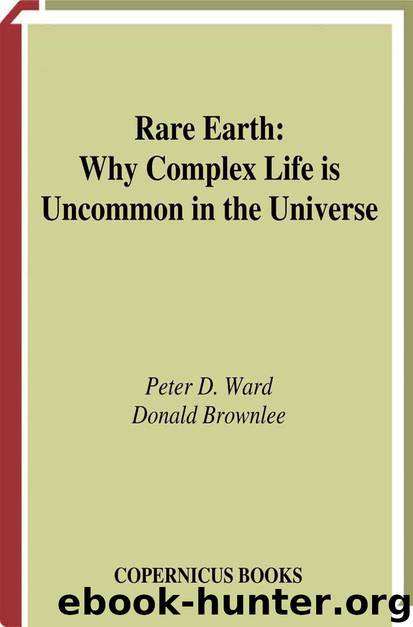Rare Earth: Why Complex Life is Uncommon in the Universe by Peter D. Ward & Donald Brownlee

Author:Peter D. Ward & Donald Brownlee
Language: eng
Format: mobi
ISBN: 9780387218489
Publisher: Springer New York
Published: 2004-12-23T00:00:00+00:00
DIVERSITY AND DISPARITY
One of the central (and controversial) aspects of the Cambrian Explosion especially with reference to the wondrous assemblage of fossils found in the Burgess Shale localities in Western Canada (where not only early animals with hard parts but also forms without skeletons are preserved as smears on the rocks)—concerns what are called diversity and disparity. Diversity (or in this case biological diversity) is a term familiar to most of us. Overtly, it is usually understood as a measure of the number of species present. Biologists use a more sophisticated meaning, that encompasses not only the number of species present in a locality, but also the relative abundance of those species. For instance, in this more technical sense, an assemblage of organisms comprising some given number of species, each with the same number of individuals in each species, is considered more diverse than a second assemblage with the same number of species but a highly unequal distribution of the numbers of individuals that compose each species group. Disparity is a measure of the number of body plans, types, or design forms, rather than the number of species. This distinction, first articulated by paleontologist Bruce Runnegar, seems at first glance rather subtle. Surely each different species has a somewhat different body plan from every other, and thus disparity and diversity should always be equal. But this is not the case. There are millions of species on Earth today. Yet the number of general body plans is far less than this.
Among animals, the major body plans are found within the major evolutionary lineages, the phyla. As we have seen, these animal groups all arose in the Cambrian Explosion. Yet the surprising finding of paleontology is that there were very few species in the Cambrian. In his 1989 book Wonderful Life, Stephen Jay Gould describes this finding as “a central paradox of early life: How could so much disparity in body plans evolve in the apparent absence of substantial diversity in number of species?”
The history of diversity and disparity during the Cambrian Explosion (or, more properly, creating the Cambrian Explosion) is another puzzling aspect of planet Earth’s diversification of animals: Is this the only way to create animals, or just one way? Will every planet with animals create them as ours did, by evolving the entire spectrum of body plans in one great evolutionary rush among a low number of species? Or could this process be more gradual, with a slowly increasing number of species over long periods of time incrementally enlarging the number of body plans?
The Burgess Shale is clearly of major importance in understanding the initial diversification of animal life. It is largely responsible for showing us that most or all of the various animal phyla (or major body plans) originated relatively quickly during the Cambrian. But the Burgess Shale may also be telling us that not only were the body plans found on Earth today around in the Cambrian, but so too were other body plan types now extinct.
Download
This site does not store any files on its server. We only index and link to content provided by other sites. Please contact the content providers to delete copyright contents if any and email us, we'll remove relevant links or contents immediately.
| Aeronautics & Astronautics | Astronomy |
| Astrophysics & Space Science | Comets, Meteors & Asteroids |
| Cosmology | Mars |
| Solar System | Star-Gazing |
| Telescopes | UFOs |
Tools of Titans by Timothy Ferriss(8218)
Turbulence by E. J. Noyes(7936)
Secrets of Antigravity Propulsion: Tesla, UFOs, and Classified Aerospace Technology by Ph.D. Paul A. Laviolette(5309)
Astrophysics for People in a Hurry by Neil DeGrasse Tyson(5131)
Room 212 by Kate Stewart(5035)
Design of Trajectory Optimization Approach for Space Maneuver Vehicle Skip Entry Problems by Runqi Chai & Al Savvaris & Antonios Tsourdos & Senchun Chai(5011)
Pale Blue Dot by Carl Sagan(4912)
The David Icke Guide to the Global Conspiracy (and how to end it) by David Icke(4625)
A Journey Through Divination and Astronomy by Publishing Pottermore(4344)
Goodbye Paradise(3727)
Apollo 8 by Jeffrey Kluger(3637)
COSMOS by Carl Sagan(3554)
Losing the Nobel Prize by Brian Keating(3498)
The Five People You Meet in Heaven by Mitch Albom(3475)
How to Read Water: Clues and Patterns from Puddles to the Sea (Natural Navigation) by Tristan Gooley(3406)
Brief Answers to the Big Questions by Stephen Hawking(3369)
How to Read Nature by Tristan Gooley(3249)
The Order of Time by Carlo Rovelli(3145)
A Brief History of Time by Stephen Hawking(2960)
